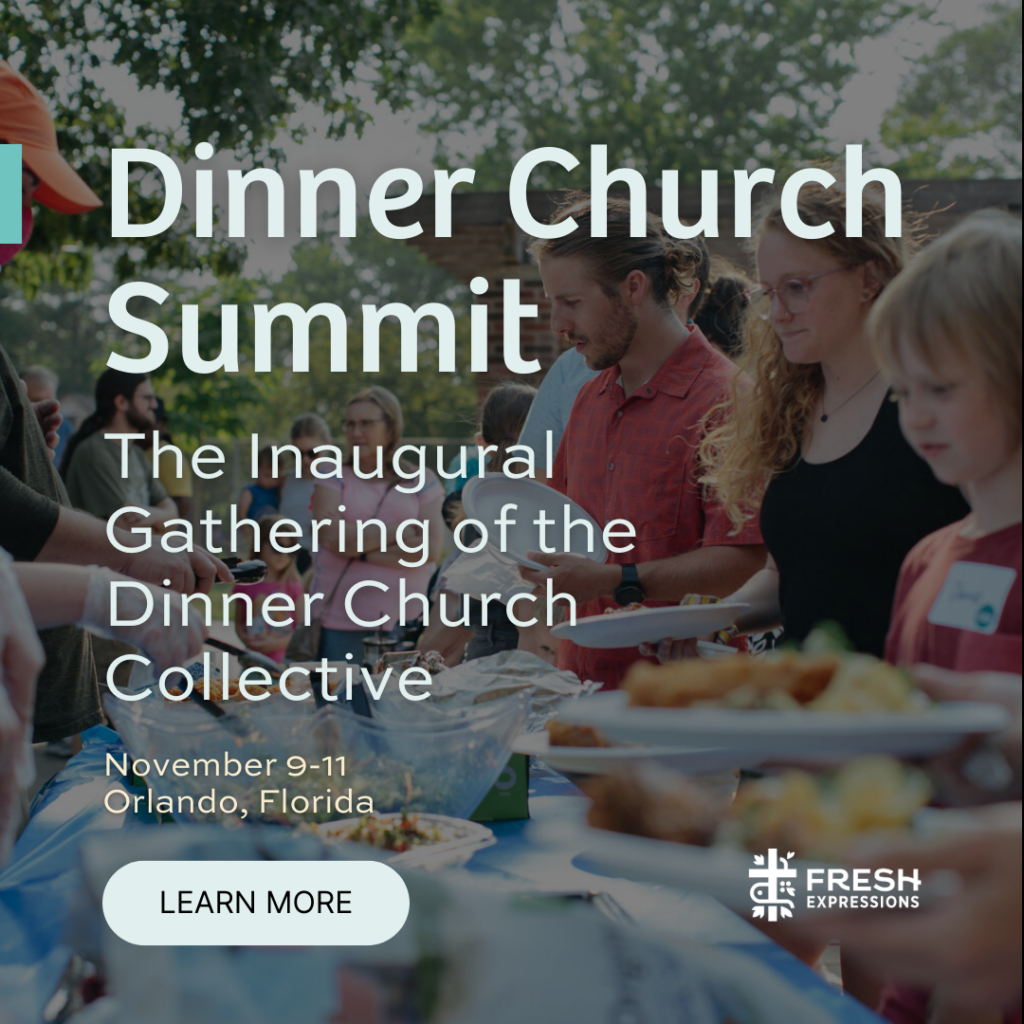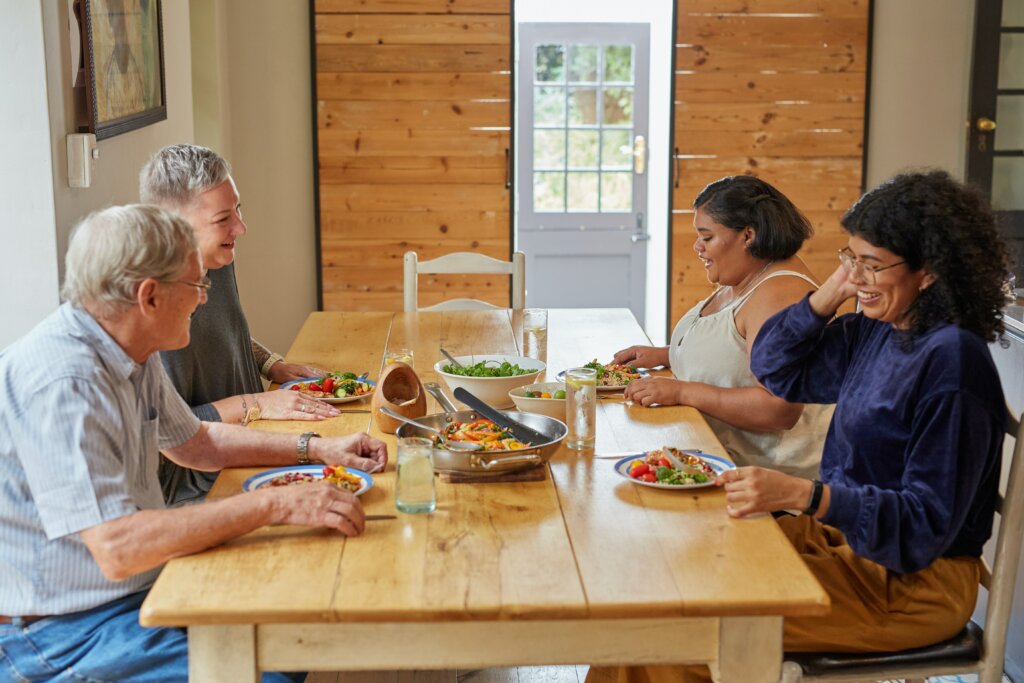You’ve read some articles and some books. You’ve been in some webinars and on-line classes. You’ve attended some training in person. You’ve taken some prayer walks and begun a process of understanding your community and context. By that investment of time, energy and resources and by the prompting of the Holy Spirit, you are even convinced you should launch fresh expressions of Church in your area. What do you do next?
I have navigated those very same issues and done those exact things and came to see that a Dinner Church, a Community Dinner, was the good place to begin. Working within a historic, traditional, sacramental and liturgical congregation we came to see and hear a missional call to reach people with the Gospel, to tell them of God’s love and the joy of knowing Jesus.
This call has always been there, even anchored in our baptismal covenant in a promise we make. We are asked; “Will you proclaim by word and example the Good News of God in Christ?” The people respond, “I will, with God’s help”. In these days of comprehensive change our former ways of reaching out to people were ineffective. We needed something new.
The most common place, easiest to understand, something these traditional Sunday morning Christians could wrap their arms around was a table. Here are some compelling reasons, a missional warrant for establishing a faith community around a table and a meal.
God’s mission is to establish His Kingdom as in heaven so on earth; the Church is the means by which the Kingdom of God is manifest on the earth.
Sadly, many local congregations’ primary function is sustaining their current ministry; they see their church as an institution that serves their own need for relationship and spiritual experiences.
We need to help people understand the church as a missional force, spreading the Gospel often one life at a time. This can happen at a table around a meal and can look very different from a traditional church model.
Five Persuasive Reasons for Starting a Dinner Church
Jesus Did It
As you read through the Gospels notice how much ministry, teaching, how many miracles happened at meals and around food. From the feeding of 5000; to dinners at Simon’s, Zacchaeus’, Matthew’s home and others; to resurrection appearances, to the establishment of the Lord’s Supper all of these and more were principal practices and how Jesus connected with people. Meals were a regular pattern in Jesus’ ministry for lost people getting found, broken people being restored, sick and wounded people getting healed. Jesus models for us the table as a central location for the mission of the church to be fulfilled.
Gathering for a Meal is a Gospel Template
Many of the things we do as a traditional western church were birthed in the Reformation. The Reformation Church needfully became focused on the Word of God as essential doctrines were being taught and embraced. Church in the cultural west became a place to hear a sermon, to be trained and this was the primary spiritual formation task, cultivating orthodox (correct) faith.
We should also consider orthopraxis, that is, correct actions and practice. Around a table relationships occur; engagement, connection and interaction take place. At a meal we get to know one another. Jesus did this time and time again it was his practice. Read the Gospels and count the times food is referenced in encounters, parables, teachings and actual meals. If Jesus kept a calendar it would be filled with dinner appointments.
The Table is a Place of Redemption
I love the story of Zacchaeus (Luke 9:1-10) a tax collector and a “sinner”. He meets Jesus and Zacchaeus welcomes Jesus to his home. Simply being in the presence of Jesus, Zacchaeus becomes generous and amends his ways. Jesus announces “Today salvation has come to this house, because this man, too, is a son of Abraham. For the Son of Man came to seek and to save the lost.”
After calling Matthew, (Matthew 9:9-13) another tax collector, we have this account.
Jesus reclined at table in the house, behold, many tax collectors and sinners came and were reclining with Jesus and his disciples. And when the Pharisees saw this, they said to his disciples, “Why does your teacher eat with tax collectors and sinners?” But when he heard it, he said, “Those who are well have no need of a physician, but those who are sick. Go and learn what this means: ‘I desire mercy, and not sacrifice.’ For I came not to call the righteous, but sinners.”
The Table is a Place of Hospitality
Getting an unbeliever, a secular person to drive on to the church campus, park their vehicle and cross the threshold of traditional church building is a daunting task. If it happens at all it is usually because someone, a friend, asked them to come.
We made an invitation to our small town, a rural community, our neighbors; It said, “Join us in a community dinner, to connect with neighbors, build some friendships and talk about life and faith”. 35 new people, not connected to the congregation, showed up. We had a warm welcome, a tasty meal, we were kind and generous, we noticed people and paid attention to who they were.
In Matthew 9, Jesus saw the crowds and had compassion on them for they were lost, like sheep without a shepherd. Jesus was moved with compassion and we should be too. Compassion is an essential element of hospitality.
Henri Nouwen writes, “Hospitality is not to change people, but to offer them space where change can take place.” The Table is a landscape offering a chance to change, to grow; in a sense, get better, be better than we were. We are invited to be made new and in that divine hospitality we are given a space to lay aside our regrets, our failures and experience forgiveness and reconciliation. The community of faith becomes a hospital where people touch a comprehensive healing, body, soul, mind and spirit.
A Table is a Place of Revelation
The resurrected Jesus made appearances to his disciples and most involved food. On Easter afternoon with two disciples on the Emmaus Road Jesus reveals himself in the breaking of the bread. Easter evening, Jesus eats with his disciples. On the Sea of Galilee, there is another miraculous catch of fish and breakfast awaits the disciples as they come ashore to behold the Risen Lord. These encounters show us that somehow and by some means Jesus is made known, his resurrection, divinity, commissioning, is facilitated by a meal. Tables become the locale where Jesus is experienced. We might call them “Glory Tables” as the manifest presence of the Risen Lord is witnessed.
I was sitting with some folks (unchurched / dechurched) at our community dinner, they did not know who I was but when they found out I was a priest the conversation as you might expect took a turn toward religion. I turned it to history and started talking about the beginning of the Church of England and the amazing 1500’s; a century of reformation, exploration, innovation and more. I shared with them how William Tyndale’s translation of the bible into English and the Book of Common Prayer written by Thomas Cranmer were so rich in language, vocabulary, and cadence. I shared this quote, “Without William Tyndale and Thomas Cranmer we would not have a William Shakespeare”. I then quoted some of Tyndale’s biblical texts and some of Cranmer’s prayers. They were moved by the language, the words had deep meaning. Not sure how to explain it but the weight of the Lord’s presence was manifest around that table with food and conversation, it was a revelation.
Like we see through the life and ministry of Jesus, relationships are formed around a meal; people connect, share stories, they listen and learn and where 2 or 3 are there, so is the Lord.
Life Changing Things Happen When Sharing a Meal
The gifts and fruit of the Spirit are obvious. Wisdom, discernment, faith, miracles, healings are tangible at table. Love, joy, peace, patience, kindness, compassion, goodness, faithfulness are evident when we break bread. We may be in a rush at a meal but if we slow down, use our senses we will see that a meal can be a sacred, holy moment where people are loved.

Elements of a Successful Dinner Church Launch
Lets get practical. How do you do this? What does it look like?
Build a Team
Build a team and call them to a passionate mission to transform your little corner of the world; the people on your street, in your neighborhood. Let them be zealous to see this happen. Teach them how to have authentic, honest conversations with people they do not know. Pray for the Holy Spirit to anoint your folks with a Gift of Hospitality.
Over the years I have known people, couples who have this gift of hospitality. As I was leading a new church plant, at the launch, our opening day, I witnessed something I had not seen before. There was a corporate manifestation of godly hospitality. The whole of the launch team flowed in kindness, being tangibly present with people in conversation, laughter and joy. We set a magnificent table of great food that facilitated the birth of this new faith community and all people who came to check out this new congregation’s launch stayed for over an hour after the service was over. As I look back to that day I realize it was a holy moment of grace. We became known for our hospitality, it was and is a trademark of that church that has grown over the years.
Plan a good meal
It does not have to be fancy or expensive. Our first Community Dinner we had “Walking Tacos”. It was simple, tasty, and diverse as folks could go vegetarian if they wanted to. Some delicious homemade cookies rounded out our menu!
Invite People
You can’t just expect people to show up. Announce your gathering everywhere you can. Use signs, flyers, cards, social media, go door to door, make it personal, relational and engaging. But don’t stop there. Personally invite friends, neighbors and anyone else you think could benefit.
Have a Plan
Even though Dinner Church is simple, having a basic plan can ensure that your team is on the same page and your visitors enjoy themselves.
- Gather to eat. Welcome people, orient them to the space, maybe have name-tags and have those casual conversations.
- Say a blessing. Remember, you will have a mixed crows, so make it simple and “unchurchy.” You can say something like “Jesus, you really liked it when people would hang out together, share a meal, I think you would be happy about what we are doing here tonight. Please bless this food and bless us! Amen”.
- Have some music. Whether canned or live, good music can give cover over many other shortcomings. Whether instrumental or live singing, it can give people something to do as they listen. We hosted a St. Patrick’s Day dinner (yes, we ate corned beef and cabbage). I downloaded and put together a playlist of Irish Folk Music so what we did fit the theme.
- Encourage interactions. Give people ways to connect around the tables like puzzles, games, mixers, and suggested discussion questions. You can print your own placemats and have pencils, markers, crayons. You might even come up with a crossword puzzle or a word search that is contextualized to your community or your theme. Leave space for someone to draw a family portrait or a local landscape. Print the recipes of the meal you are serving. Give away a door prize or two, which is fun, and it also helps collect contact information for follow-up.
- Tell a Jesus Story. This is a simple story about Jesus, something He did or said. For example, you could say something as simple as “In Luke’ account of Jesus’ ministry and life, Jesus tells three stories about lost things, A Lost Sheep, A Lost Coin, A Lost Son.” Then read the account from Luke 15 from an easy to understand translation like The Message. After reading, go on to explain the text by saying something like “this story teaches us that God cares about lost things. He wants lost things to be found, and for his lost children to come home. He does this because He loves us. If you’ve strayed, making the journey home can be tough but Jesus tells us; there is a Good Shepherd to care for and restore the sheep, we are a valuable possession worth finding; there is a loving Father to welcome back into the family. It really is Good News!”
- Facilitate conversation. Offer a question or two around the table about the Jesus Story. Working on the Jesus Story above: Share a time when you were lost and how you got found. How does this Jesus story resonate with you? Does it make sense? Do you have any questions?
- Give a Benediction. Send them off with love and any of the leftovers. Print the benediction on cards and say it in unison. Here’s an example, taken from Tyndale’s translation of the Bible – from Numbers 6:24-26.
The Lord bless you and keep you;
The Lord make his face shine on you and be gracious to you;
The Lord turn his face toward you and give you peace. - Do it Again. We started with a 4-6 week rhythm of Community Dinners and all of our gatherings found a theme; around a holiday, a church feast or saint’s day. At each dinner we announced the next one inviting people to join us again.
Just Get Started
You can start a Dinner Church. It’s a simple thing can change someone’s world, help them to feel a part, to belong.
One of the faith formation trends that has emerged in the last decade or so is people will belong before they believe. Both belonging and believing can happen at a table. The table becomes a place where strangers become friends, people come home and join God’s family.


